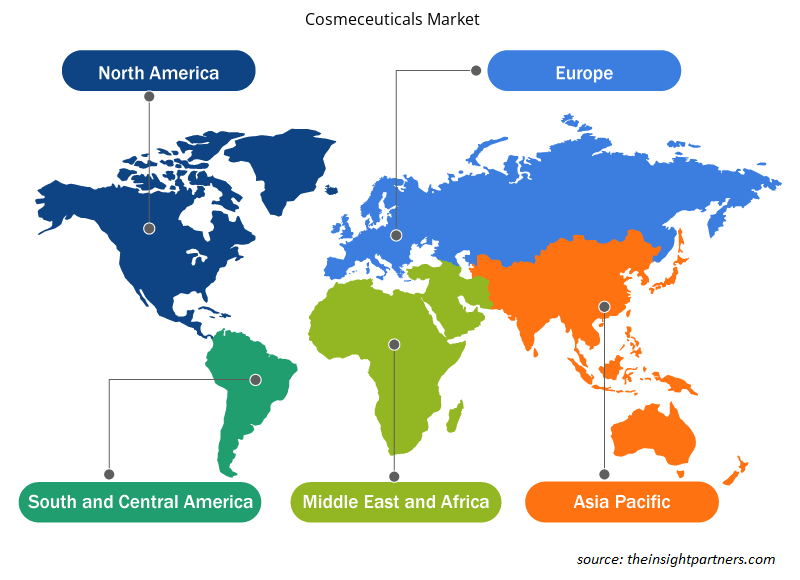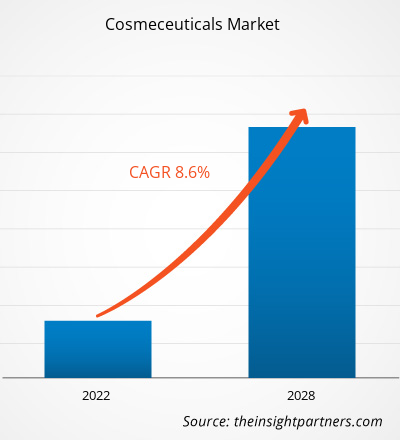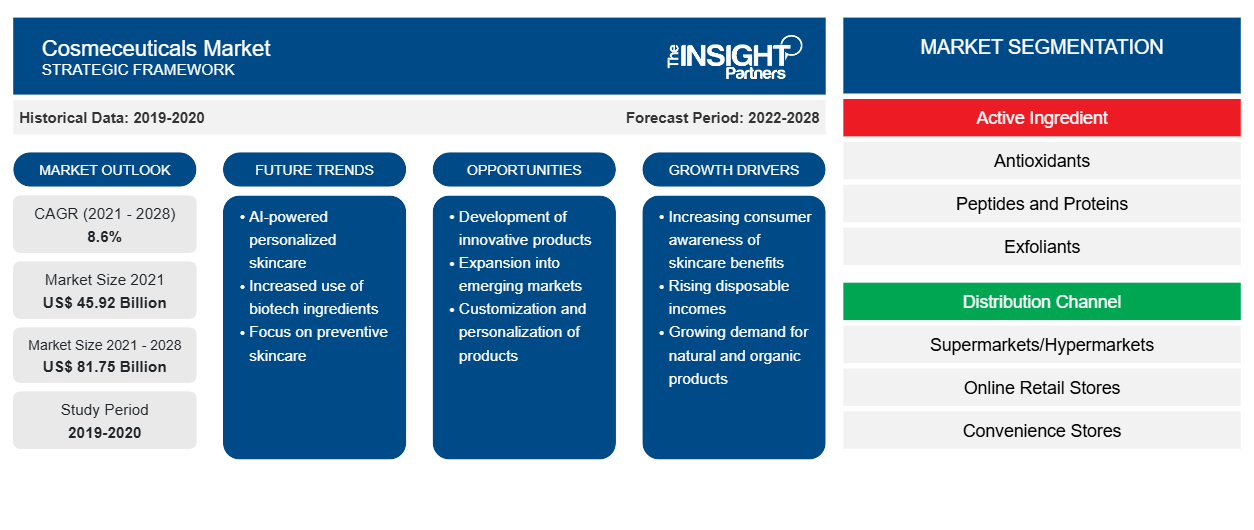[연구보고서] 화장품 시장 규모는 2021년 459억 1,666만 달러에서 2028년 817억 5,336만 달러로 성장할 것으로 예상되며, 2021년부터 2028년까지 연평균 성장률 8.6%를 기록할 것으로 추산됩니다.
분석가 관점
화장품 시장은 화장품 산업 내에서 제품과 제약 속성을 결합한 세그먼트를 의미합니다. 이러한 제품은 보다 집중적이고 과학적으로 진보된 제형을 제공함으로써 전통적인 화장품과 제약 간의 격차를 메웁니다. 화장품 시장은 개인의 외모에 대한 소비자 인식 증가, 가처분 소득 증가, 노화 방지 및 스킨 케어 제품에 대한 수요 증가와 같은 요인에 의해 주도됩니다. 기술과 연구의 발전도 혁신적인 화장품 제품 개발에 기여했습니다. 화장품 시장 내의 제품 범주에는 스킨 케어, 헤어 케어, 구강 케어가 포함되며, 이 세그먼트에서 가장 인기 있는 것은 자외선 차단제입니다. 헤어 케어 제품은 탈모, 비듬과 같은 문제를 해결하여 모발 건강을 개선하는 데 중점을 둡니다. 구강 케어 화장품에는 치약, 구강 세정제 및 구강 건강을 증진하는 기타 제품이 포함됩니다. 화장품 제품은 주로 소매점, 전문 매장, 전자 상거래 플랫폼과 같은 다양한 채널을 통해 유통되며 화장품의 시장 성장과 접근성을 확대하는 데 중요한 역할을 했습니다.
시장 개요
화장품은 잠재적인 약리적 특성을 가진 생물학적 활성 성분을 함유한 화장품입니다. 화장품은 미용적 이점을 제공하는 동시에 특정 피부 또는 모발 문제를 타깃으로 하여 단순한 미적 개선 이상을 제공하도록 설계되었습니다. 화장품과 일반 화장품의 차이점은 과학적으로 연구되어 피부와 모발에 특정 이점을 제공하는 것으로 입증된 성분에 있습니다. 이러한 성분에는 항산화제 , 펩타이드, 비타민, 레티노이드, 히알루론산, 식물 추출물 및 기타 생물학적 활성 물질이 포함될 수 있습니다. 화장품 시장은 소비자가 점점 더 화장품과 피부 또는 모발 건강상의 이점을 모두 제공하는 제품을 찾으면서 상당한 성장을 보였습니다. 화장품 시장은 경쟁이 치열하며, 여러 주요 기업과 수많은 소규모 기업이 전 세계적으로 운영되고 있습니다. 이 회사들은 혁신적인 화장품 제품을 출시하고 경쟁 우위를 유지하기 위해 연구 개발에 많은 투자를 합니다. 화장품 시장은 혁신, 과학적 발전, 진화하는 소비자 선호도에 의해 주도되어 기존 기업과 신규 진입 기업 모두에게 기회를 창출합니다.
귀하의 요구 사항에 맞게 이 보고서를 사용자 정의하세요
이 보고서의 일부 또는 국가 수준 분석, Excel 데이터 팩을 포함하여 모든 보고서에 대한 사용자 정의를 무료로 받을 수 있으며 신생 기업 및 대학을 위한 훌륭한 혜택과 할인 혜택을 이용할 수 있습니다.
-
이 보고서의 주요 시장 동향을 알아보세요.이 무료 샘플에는 시장 동향부터 추정 및 예측까지 다양한 데이터 분석이 포함됩니다.
시장 드라이버
신흥국의 개발 기회로 시장 성장 촉진
중동, 아프리카, 아시아 태평양과 같은 지역의 신흥 시장은 주요 시장 참여자들이 사업을 확장할 수 있는 상당한 기회를 창출하고 있습니다. 대부분의 참여자들은 만성 질환을 앓고 있는 인구가 많은 인도와 중국과 같은 개발 도상국 시장에 집중합니다. 의료 서비스 회사는 관행에 대한 생산 비용이 증가함에 따라 투자자들을 즐겁게 할 수 있는 충분한 수익을 창출하기 위해 노력하고 있습니다. 몇몇 성장 경제권의 시장은 주요 참여자들이 산업과 지리적 범위를 확장할 수 있는 보다 안정적이고 수익성 있는 성장 기회를 제공하는 데 필수적인 부분이 될 것으로 기대됩니다.
생명공학의 발전으로 화장품 수요가 증가하여 더욱 맞춤화된 제품 출시가 촉진되고 개인화된 화장품으로의 전환이 용이해졌습니다. 업계의 다양한 업체가 화장품 시장에서 사용될 더 우수하고 진보된 제품과 기술을 개발하기 위해 상당한 수익의 상당 부분을 R&D 활동에 투자해 왔습니다. 아시아 태평양 시장은 일본과 같은 국가에 상당한 바이오제약 회사가 있고 중국과 인도와 같은 국가에 현지 회사가 늘어나고 있기 때문에 예측 기간 동안 가장 빠른 성장을 보일 것으로 예상됩니다. 이 지역의 이러한 활동은 이 지역의 화장품 수요를 증가시키고 있으며 예측 기간 동안 화장품 시장에서 활동하는 업체에게 상당한 성장 기회를 제공할 것으로 예상됩니다. 따라서 위에서 언급한 요인들이 예측 기간 동안 화장품 시장을 주도하고 있습니다.
세그먼트 분석
화장품 시장은 제품에 따라 스킨 케어, 헤어 케어, 구강 케어 및 기타로 분류됩니다. 2021년에는 스킨 케어 부문이 화장품 시장에서 가장 큰 점유율을 차지할 가능성이 높습니다. 더욱이 이 부문은 열대 국가에서 자외선 차단제에 대한 수요가 증가하고 전 세계적으로 노화 방지 제품에 대한 수요가 증가함에 따라 2021년부터 2028년까지 화장품 시장에서 가장 빠른 CAGR로 수요가 증가할 것으로 예상됩니다. 피부 관련 문제의 유병률이 증가함에 따라 화장품 시장에서 스킨 케어 부문의 성장이 촉진되었습니다. 기후 변화와 피부에 미치는 영향으로 인해 스킨 케어 제품 사용이 증가했습니다. 산업의 수가 증가함에 따라 도시 오염 수준이 높아져 피부에 부정적인 영향을 미칠 수 있으며, 개인이 보호를 위해 더 많은 스킨 케어 제품을 찾게 되었습니다. 피부과 의사, 미용사 및 기타 전문가들은 자외선 차단을 가장 중요한 피부 관리 요구 사항 중 하나로 광범위하게 옹호하고 강조합니다. 소비자들은 자외선뿐만 아니라 청색광, 흡연, 스모그, 오염, 세균, 박테리아 및 바이러스로부터도 자신을 보호해야 한다는 사실을 점점 더 인식하고 있습니다. 결과적으로 제조업체는 보다 전문적인 자외선 차단제, 청색광 보호 요법, 항산화 세럼 및 항균 제품 혁신에 집중해야 합니다. 예를 들어, 2023년 1월, Oriflame은 스킨케어 제공을 확대하기 위해 코스메슈티컬 제품군을 출시했습니다. Oriflame은 스킨케어 제공을 인도 시장으로 확대하고 'NovAge Proceuticals'라는 이름의 첫 번째 '코스메슈티컬' 제품군을 출시했습니다. 화장품 및 뷰티 사업의 새로운 라인은 고객의 특정 피부 문제를 해결하도록 설계되었습니다. 따라서 위에서 언급한 요인들이 예측 기간 동안 코스메슈티컬 시장에서 스킨 케어 부문을 주도하고 있습니다.
지역 분석
북미 화장품 시장은 2021년에 12,918.33백만 달러로 평가되었으며 2028년까지 23,275.18백만 달러에 도달할 것으로 예상되며 예측 기간 동안 8.8%의 CAGR로 성장할 것으로 예상됩니다. 북미 화장품 시장은 미국, 캐나다, 멕시코로 세분화됩니다. 미국은 북미에서 가장 큰 화장품 시장을 차지했으며, 화장품 시장은 노화 방지 제품에 대한 수요 증가와 화장품에 대한 온라인 및 전자 상거래 구매 구조 채택 증가로 인해 성장할 것으로 예상됩니다. 건강을 목적으로 하는 피부, 모발, 구강 위생과 관련된 인식 추세는 국가의 공중 보건을 개선할 수 있는 전례 없는 기회를 나타냅니다. 점점 더 강력해지는 이러한 서비스는 건강 서비스에 대한 접근성을 개선해야 하는 사람들에게 생명선이 되고 있으며, 이는 화장품 시장의 성장을 촉진할 것입니다.
게다가 소비자들은 새로운 제품을 시도하고 새로운 방식으로 브랜드와 상호 작용하고 있는데, 이는 뷰티 블로거의 등장으로 가능해졌습니다. 뷰티 블로거는 자신이 좋아하는 페이스 크림, 립스틱, 마스카라 , 콤팩트 파우더 등에 대한 YouTube 튜토리얼과 Instagram 스토리를 공유합니다. 많은 화장품 회사가 기존 광고를 포기하고 브랜드를 타겟 고객에게 홍보하기 위해 유명 인사와 인플루언서를 고용하는 것을 선호합니다. 따라서 미국 화장품 시장은 역사적 기간 동안 화장품에 대한 수요가 급증했습니다. 따라서 위에서 언급한 요인들이 이 지역의 화장품 시장 성장을 촉진할 것으로 예상됩니다.
주요 플레이어 분석
화장품 시장 분석에는 L'Oreal SA, Beiersdorf Global, Croda International, Amway Corp., Allergan, Unilever PLC, Johnson & Johnson, Procter & Gamble, Avon Products Inc., BASF SE 등의 기업이 포함되며, 이들 기업은 다양한 제품 포트폴리오를 제공하기 때문에 상위 2대 기업입니다.
화장품 시장 지역 통찰력
Insight Partners의 분석가들은 예측 기간 동안 Cosmeceuticals 시장에 영향을 미치는 지역적 추세와 요인을 철저히 설명했습니다. 이 섹션에서는 북미, 유럽, 아시아 태평양, 중동 및 아프리카, 남미 및 중미의 Cosmeceuticals 시장 세그먼트와 지리에 대해서도 설명합니다.

- 화장품 시장에 대한 지역별 특정 데이터 얻기
화장품 시장 보고서 범위
| 보고서 속성 | 세부 |
|---|---|
| 2021년 시장 규모 | 459억 2천만 달러 |
| 2028년까지 시장 규모 | 817억 5천만 달러 |
| 글로벌 CAGR (2021-2028) | 8.6% |
| 역사적 데이터 | 2019-2020 |
| 예측 기간 | 2022-2028 |
| 다루는 세그먼트 |
활성 성분별
|
| 포함된 지역 및 국가 |
북아메리카
|
| 시장 선도 기업 및 주요 회사 프로필 |
|
화장품 시장 참여자 밀도: 비즈니스 역학에 미치는 영향 이해
코스메슈티컬 시장 시장은 소비자 선호도의 변화, 기술 발전, 제품의 이점에 대한 인식 증가와 같은 요인으로 인해 최종 사용자 수요가 증가함에 따라 빠르게 성장하고 있습니다. 수요가 증가함에 따라 기업은 제품을 확장하고, 소비자의 요구를 충족하기 위해 혁신하고, 새로운 트렌드를 활용하여 시장 성장을 더욱 촉진하고 있습니다.
시장 참여자 밀도는 특정 시장이나 산업 내에서 운영되는 회사나 기업의 분포를 말합니다. 주어진 시장 공간에 얼마나 많은 경쟁자(시장 참여자)가 존재하는지 그 규모나 총 시장 가치에 비해 나타냅니다.
화장품 시장에서 활동하는 주요 기업은 다음과 같습니다.
- 엘
면책 조항 : 위에 나열된 회사는 어떤 특별한 순서에 따라 순위가 매겨지지 않았습니다.

- 화장품 시장 주요 기업 개요를 알아보세요
최근 개발 사항
합병 및 인수와 같은 무기적 및 유기적 전략은 화장품 시장에서 회사들이 많이 채택하고 있습니다. 화장품 시장에서 최근 몇 가지 주요 시장 개발은 다음과 같습니다.
- 2021년 8월, Shiseido Company, Limited는 중국 자회사인 Shiseido China Co., Ltd.와 Boyu Capital 간에 Shiseido Beauty Innovations Fund를 출범시키기 위한 프레임워크 계약을 발표했습니다. 이 펀드의 운영은 Boyu와 Shiseido가 수행하며, 중국에서 관련 규제 서류 제출을 완료한 후 올해 시작될 예정입니다. 이 펀드는 화장품 및 웰빙 분야의 중국 신흥 브랜드와 전자 상거래 서비스 및 소비자 경험 기술과 같은 관련 기술 기업 간의 투자 기회를 모색할 것입니다.
- 2021년 7월, 로레알 그룹은 뷰티 산업의 미래에 대한 진보적 비전에 따라 최초로 TikTok 뷰티 채널을 시작했습니다. 이 채널은 세계에서 가장 인기 있는 뷰티 제품을 넘어 그룹의 과학, 혁신 및 기술을 공개합니다. 로레알의 전문가와 협력하여 이 새로운 채널은 뷰티 제품의 과학, 혁신 및 기술을 결합한 콘텐츠를 제공합니다.
- 과거 분석(2년), 기준 연도, CAGR을 포함한 예측(7년)
- PEST 및 SWOT 분석
- 시장 규모 가치/거래량 - 글로벌, 지역, 국가
- 산업 및 경쟁 환경
- Excel 데이터세트
최근 보고서
사용 후기
구매 이유
- 정보에 기반한 의사 결정
- 시장 역학 이해
- 경쟁 분석
- 고객 인사이트
- 시장 예측
- 위험 완화
- 전략 기획
- 투자 타당성 분석
- 신흥 시장 파악
- 마케팅 전략 강화
- 운영 효율성 향상
- 규제 동향에 발맞춰 대응























 무료 샘플 받기 - 코스메슈티컬 시장
무료 샘플 받기 - 코스메슈티컬 시장